Faerie Dragon featured image is a combination of images credited to Wizards of the Coast’s D&D 5e book Monster Manual and art by Michael Krahn on Unsplash.
Disclaimer: This article contains affiliate links that add gold to our coffers.
Hello and welcome to this edition of Expanding Monsters, where we take a look at monsters in the 5e Monster Manual and expand their lore, scope, and mechanics to make them more exciting and applicable to any setting. Today we’ll be looking at Faerie Dragons and how they interact with others in the planes and how they can join as a more detailed part of any world lore.
Faerie Dragons: A Missed Opportunity
A few hundred words, lost in the middle of the Monster Manual on page 133, stuck between Ettin and Flameskull, the Faerie Dragon is one of the most overlooked monsters in 5th edition D&D. Add on top of that a complex challenge rating and abilities chart, many StoryCrafters might just pass over the potential of this Dragon for something more simple or flashy. The Faerie Dragon is also called Feydragon in other bestiaries, I’ll be using these terms interchangeably throughout the article. If you are one of the few StoryCrafters that integrate these amazing creatures into your setting, I commend you. What I write in this article is one of many potential interpretations of how this creature can be used in lore, take what you like, and leave what you don’t.
Draconic Tricksters
The magic of the Feywild touches and changes all that call it home, with Illusion and Enchantment magic at its core. Even the powerful dragons bend to the will of the plane and as a result of generations of persistence in the Feywild, Feydragons have evolved. Faerie Dragons lack most of the characteristic markers of True Dragons (Chromatic or Metallic), as they eschew size, presence, and fear in lieu of trickery, observation, and knowledge.
While it is easy to see the extreme variety of Faerie Dragons and assume that they are different creatures, they are all just variations of the same species. The natural ability for draconic creatures to adapt and change their physical bodies to fit their environment is exemplified in the Feydragons. They have the ability to build cocoons and shed their old bodies like a change of clothes to better fit their environment within a few days. Typically this happens when the Faerie Dragon transits to a different plane, biome, or settles in a sapient town. The cocoon itself is one that exists to protect the Feydragon during metamorphosis, typically using invisibility magic or illusions to fool or lure away predators. Once the transformation is complete the dragon will choose to stay in its new environment until they are forced to move, or the area becomes too boring to sustain their mood.
Trickery is the mainstay of any creature of the Feywild, if a fey creature isn’t sewing chaos, it is to be expected that they are dead or on the way to it. Feydragons are still dragons, they hoard things, mostly baubles, trinkets, and other small shiny things, but the thing that they love most is gossip and knowledge. Whether it be the bickering chatter of squirrels fighting over an acorn or the simmering love triangle between the Mayor, Mistress, and Inn Owner, the Fey Dragons love all the small things that go on in the area that it has settled. They will frequently “stir the pot” in order to make things more interesting. Should that love letter find its way into the wrong hands, it certainly would result in a major scandal and a Faerie Dragon would ensure that the letter finds its way into the wrong hands. Like a screenplay from a telenovela, Faerie Dragons watch the comings and goings of a population as a form of entertainment and will manipulate it if it isn’t spicy enough for their tastes.
One important thing to remember about the Feydragons is that they prefer argument and manipulation over any form of physical conflict or violence. While they aren’t above eliminating small animals and pets to feed their appetites when it comes to a conflict that may result in injury or death, they will be sure to attempt a trick, illusion, or just run away. While they may shy away from direct physical altercations, they savor the opportunity to trick someone else into deadly combat.
Omens of the Feywild
Feydragons on the material planes are typically signs from when a rift between the planes allows or has allowed for transit, old Feydragons stranded on the material plane are orphans of a rift that has been closed. Most of the time, this transit through the Feyrift is not noticed by the Faerie Dragons as they will settle anywhere. A recent incursion of these creatures into a town could indicate a nearby rift where more prominent fey could be bleeding into the material plane. Magic Component hunters frequently look for Feydragons as a sign that they could be near a Feyrift, and many of these hunters may bargain with the Faerie Dragon for additional information concerning the location of the rift and what creatures could reside there.
Feydragons are rare among the fey in that they rarely take sides in the Seelie and Unseelie courts. Primarily they are dragons, the dichotomy of the courts in the feywild do not concern them, and they view the interplay between the two types of fey as more of a drama and source of entertainment than a conviction. Due to this, they are frequently used as intermediaries when it comes to court relations when an intermediary is needed, which is rare. The connection with natural magic that all draconic creatures enjoy meshes well with the natural magic of the Feywild and allows them to bypass the need for fealty to the fey courts, though they don’t form a complex society on their own. Feydragons individually may choose to join the Seelie or Unseelie out of necessity or whim, when they do, they become great assets to the Lord that convinced them to join, the abilities of a Faerie Dragon are subtle but powerful.
Due to their neutral nature, many Fey converse with and bribe Faerie Dragons for information on other Fey in the area. Bribes may include a bauble that is particularly shiny, delicious food, or compromising information on another Fey. Hoarding information is the business of a Feydragon, and the more a creature seems to want a piece of information, the more a bribe could increase or change, the fickle nature of the Fey would make the cost of information fluctuate wildly. Many magical component hunters say that it is an artform to coax information out of a Feydragon, and the best negotiators can get information for free through the use of deception, leading a conversation, and feigned dismissal of critical information.
A Faerie Dragon wants to feel important and will frequently flaunt knowledge in hopes that you will become interested in knowing more. It’s attempting to get a bribe out of you for more knowledge, a good negotiator can guide a conversation to trick the Faerie Dragon into giving you the information you need while it is trying to sell you for more. Feigned indifference is the key to successful negotiations, the more it realizes that you want something, the more the cost of that knowledge will go up. – Gerrick, Magic Component Hunter.
Fearie Dragons Physically Rooted in Magic
The physiology of a draconic creature is intriguing. Add in the fact that it is stitched together with the fibers of the Feywild, and you will get a unique creature that can change its form with its mood. Metamorphosis is an innate trait for the Faerie Dragon that allows it to adapt and change according to the environment that it finds itself in. Its adaptable nature combined with innate illusionary abilities allows for an extreme amount of variety within the species, insomuch that no two Faerie Dragons are alike.
Due to their interactions with the plane, Feydragons must be in the Feywild in order to reproduce. The maturity of a mate is important to the dragons, and most will wait until they are Wyrms before choosing a lifelong partner. Not only is the color, style, and design of a potential mate important, knowledge and mischievousness rank high on how to choose a partner. It is speculated that only the mate of a Feydragon will ever truly know the real personality of the creature. Raising young is a short-lived endeavor. After a few years of teaching misdirection and distraction, young Faerie Dragons are released to cause havoc in the Feywild. A clutch of eggs typically will have 8-20 hatchlings, and they quickly develop their invisibility capabilities only hours after hatching.
As the dragons age, their coloration changes as well. This usually plays into major themes of their chosen forms. With time being erratic in the Feywild, age is typically more attuned to accumulated knowledge and magical capability over actual time spent alive. Hatchlings begin with a vibrant Red hue that migrates through Orange, Yellow, Green, Blue, Indigo, and finally Violet when the dragon is ranked as a Wyrm. It is not uncommon for members of the same clutch to vary wildly in coloration as some accelerate quickly to Wyrms while others prefer the petulance of youth and remain colored Red, Orange, or Yellow for many sapient lifetimes.
As Feydragon “grow older,” their priorities and methodology mature, the type of information that they deem important changes. A mature dragon may consider politically compromising information more important than a spat between lovers, while a young dragon may believe that everyone finds the badger hole wars the most interesting thing in the area. Likewise, they will exchange information for different bribes; older Feydragons may feel that only personally compromising information about the person they are dealing with is the only acceptable form of payment, while younger dragons would accept a delicious cupcake or a particularly shiny ring. In this way, they are demonstrating their draconic origins in the fact that they hoard what people feel are important.
No one really knows how old a Faerie Dragon will become before it loses the battle with age. The connection with the Feywild might point to the idea that they are physically immortal. Returning to the Feywild to retire and raise a clutch or two of hatchlings may be the final act of a Faerie Dragon. Some arcanists say that the great wyrms of the Faerie Dragons go on to become historians and informants for True Dragons, advising those that could use the information for power.
Abilities and Game Mechanics of Faerie Dragons
I’ll be revamping the game mechanics a bit, so I’ll list out the total of the abilities here, even if they are a word-for-word copy from the official content in the Monster Manual. I’ll make a note when there is no change from what you would expect in the book. All notes/changes will be annotated in red.
Breath Weapon: Euphoria – The Feywild’s influence on the Faerie Dragon has transformed its breath weapon into a euphoric experience. Recharge (5-6) The dragon exhales a puff of euphoria gas (range and DC as indicated in Stat Block). Affected creatures must succeed a charisma save or for 1 minute affected creatures can’t take reactions and must roll a d6 at the start of each of their turns to determine their behavior during the turn.
1-4 – The creature takes no actions or bonus actions and uses all of its movement to move in a random direction (use a d8 to determine direction). At the end of its turn, it may make a charisma saving throw, ending the effect on itself on success against the breath weapon DC.
5-6 – The creature doesn’t move. The only thing it can do on its turn is make a charisma saving throw, ending the effect on itself on success against the breath weapon DC.
Draconic Metamagic: Potent Spells – Dragons have the ability to manipulate their spells in ways that many do not expect. The spells influenced by the Feywild of a Faerie Dragon are very potent, all saving throws made against Enchantment/Illusion spells cast by the dragon are made with disadvantage, and any skill checks made to discern an illusion are made with disadvantage (if you are using passive skills this would add 5 to the DC).
Draconic Polymorph – Dragons gain the innate ability to change into other creatures, they prefer sapient creatures that they would interact with. This dragon has the ability to cast Polymorph to change into a sapient creature a number of times per day equal to their proficiency bonus. This special type of Polymorph can only transform them into a humanoid of their choice and requires concentration, and lasts for an hour. Once a dragon chooses a humanoid form, they can only Polymorph into that form until they spend a long rest picking a new humanoid form to transform into.
Enhanced Magic Resistance – The dragons’ connection to raw magic allows them to better resist the effects of magic. The dragon has advantage on saving throws against spells and other magical effects. All spell attacks that target the dragon have disadvantage on the attack roll.
Feywild Affinity – This creature can communicate with the plants and animals of the planes. This creature may cast Speak with Animals and Speak with Plants at will.
Fey Creature – This creature calls the Feywild home. This creature has advantage on saves against charm effects.
Fey Paragon – The creature is considered a master of the Feywild. This creature is immune to charm effects.
Innate Spellcasting – Dragons possess the innate ability to use magic. The dragon’s innate spellcasting ability is Charisma-based (Save 8 + prof. mod. + cha mod. / Spell attack = prof. mod. + cha mod.). It can innately cast a number of spells, requiring no material components. As the dragon ages and changes color, it gains additional spellcasting ability. The spells per day and spells known are outlined in the Stat Block.
Note on Spell Selection: If you would like to vary the spell list I would encourage you to do so, I restricted the spell selection for this creature to be Enchantment and Illusion spells only (with a few acceptions). I did so to ensure the dragon retained its flavor in the lore, but you are under no such restriction, feel free to substitute spells to fit your needs.
Limited Telepathy – The creature can communicate telepathically with others of its kind. Using telepathy, the dragon can magically communicate with any other draconic creature within 60 ft of it.
Magical Sight – This creature has the ability to see magic in all its forms. This creature is treated as having Detect Magic (as per the spell) active all the time without the need for concentration. Additionally, it has See Invisibility (as per the spell) active all the time.
Superior Invisibility – The Faerie Dragon has the ability to become invisible with a thought. As a bonus action, the dragon can magically turn invisible until its concentration ends (as if concentrating on a spell). Any equipment the dragon wears or carries is invisible with it. (No change from the Monster Manual)
Faerie Dragon Stat Blocks
The following statblocks allow you to evolve and progress the Faerie Dragons for different purposes and challenges.
Hatchling Faerie Dragon: Red Coloration
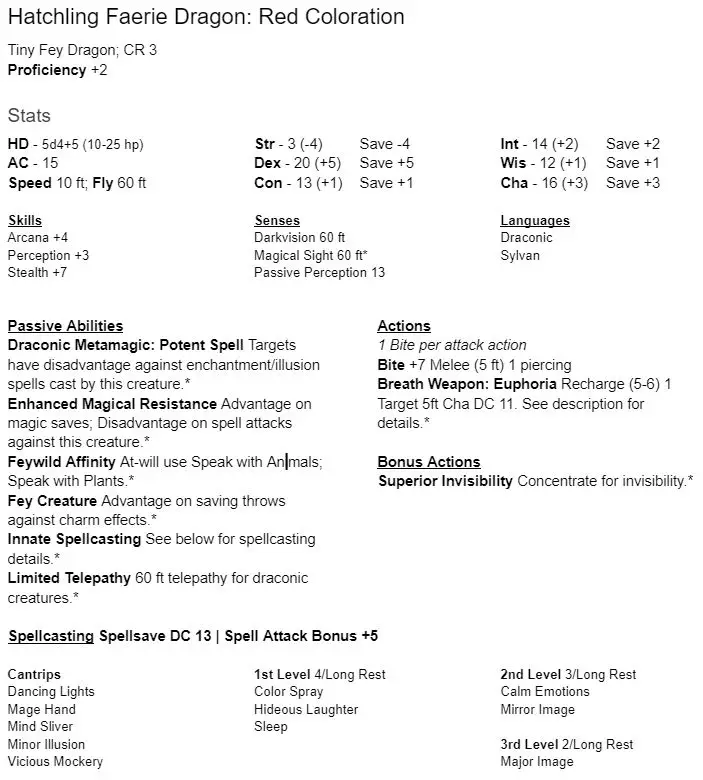
*Full description found previously in the article
The hatchling of a Faerie Dragon is arguably the most magically potent of all of the draconic species. Their ability to manipulate the world around them innately through their spellcasting enables them to dispatch enemies through means other than direct attack. The Draconic Metamagic ability of potent spells ensures that they will sew enough chaos to make an escape if cornered. Magical Sight is potentially the biggest game-changer as it allows the dragon not only to see magical auras but also to have permanent See Invisibility. This will persist throughout the whole evolution of this dragon, and will likely become a central theme of its interaction with an adventuring party.
Very Young Faerie Dragon: Orange Coloration
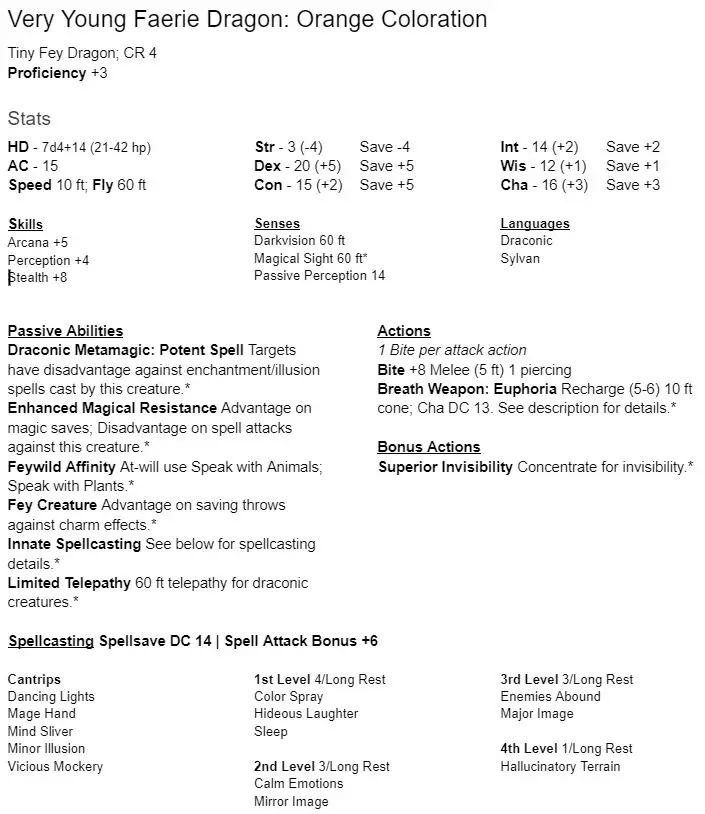
*Full description found previously in the article
As the Faerie Dragon matures its spell repertoire increases and the ability to change the perception of its environment becomes more powerful. The urge to use this power to prank or trick creatures that are found in its path only increases with age. With the addition of Hallucinatory Terrain and Enemies Abound, the combat ability of this Feydragon is increased dramatically. This is also where the breath weapon becomes more potent with a cone effect rather than just the single target. A dragon of this age will take steps to ensure that its lair is hidden using illusion spells like Hallucinatory Terrain and Major Image.
Young Faerie Dragon: Yellow Coloration
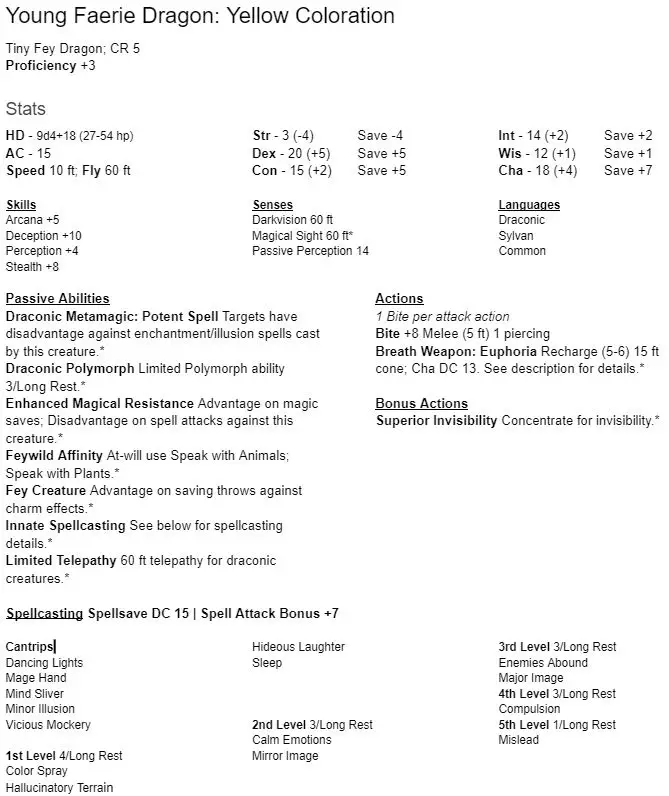
*Full description found previously in the article
Compulsion and Mislead are added to the spell list, and Draconic Polymorph is added so that the Faerie Dragon can better interact posing as a humanoid with the native populations as it is collecting information. Compulsion can be an excellent tool for getting out of a hot situation. It’s at this stage that the dragon starts to gain some of the iconic abilities that will serve the dragon well. Mislead is a great spell for interacting with potentially hostile creatures without putting themselves in direct risk of harm.
Adolescent Faerie Dragon: Green Coloration
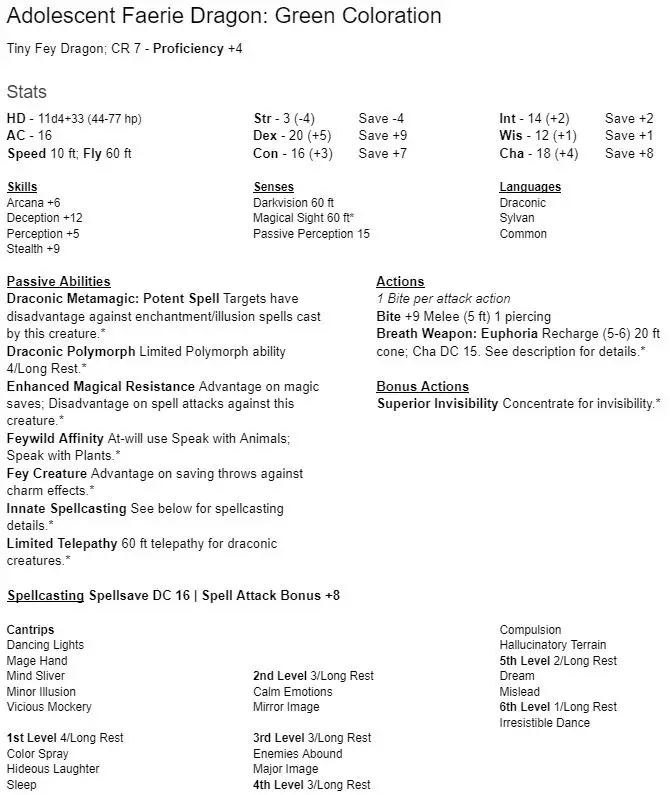
*Full description found previously in the article
This time we are adding in two really big hitters when it comes to spell selection, Dream to mess with the townsfolk and Irresistible Dance, always a classic and always hilarious. I can see a mischievous little dragon using both of these to the fullest of their respective capabilities. What better way to prank someone than to have the idea of the prank look like it came from someone that isn’t you. It’s the ultimate manipulation.
Adult Faerie Dragon: Blue Coloration
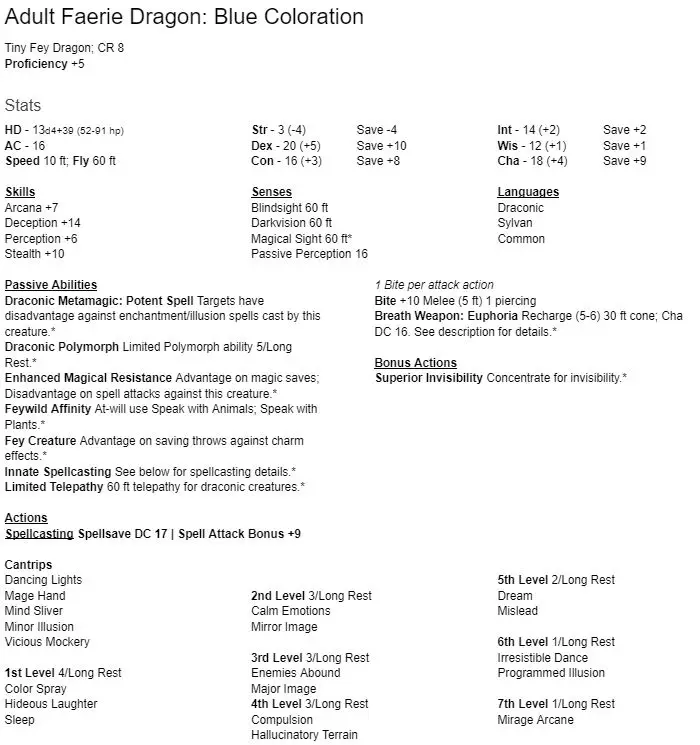
*Full description found previously in the article
With the addition of Mirage Arcane this creature becomes truly a terror as it will be able to hide towns and villages, reconstruct the landscape as part of an elaborate ploy to confuse the townsfolk. Adding extra trees to the forest, only to have the wood disappear when they try to carry it home, confusing the population with buildings that appear and disappear as the days go by. With programmed Illusion also added to the list the level of trouble that one little dragon can cause has increased exponentially, ghosts in the night repeating the same actions over and over, a long-dead hero of the town coming back to “life”.
Old Faerie Dragon: Indigo Coloration
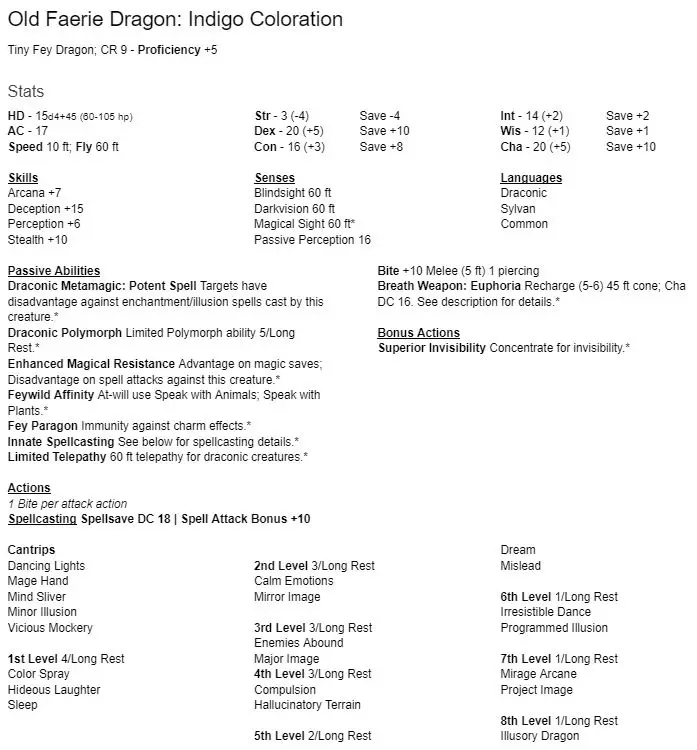
*Full description found previously in the article
The ultimate defensive move for an Illusion based caster, Illusory Dragon has been added to the spell list, and boy, will it pack a punch. This strictly is a break in case of an emergency situation… right? Adding Project Image to round out 7th level spells we are stepping more into the role and capabilities of a possible advisory role for a true dragon, or could be useful as an ally to the party. This stage also brings with it Fey Paragon which gives it immunity to charm effects, something that will ensure that it cannot be manipulated itself.
Wyrm Faerie Dragon: Violet Coloration
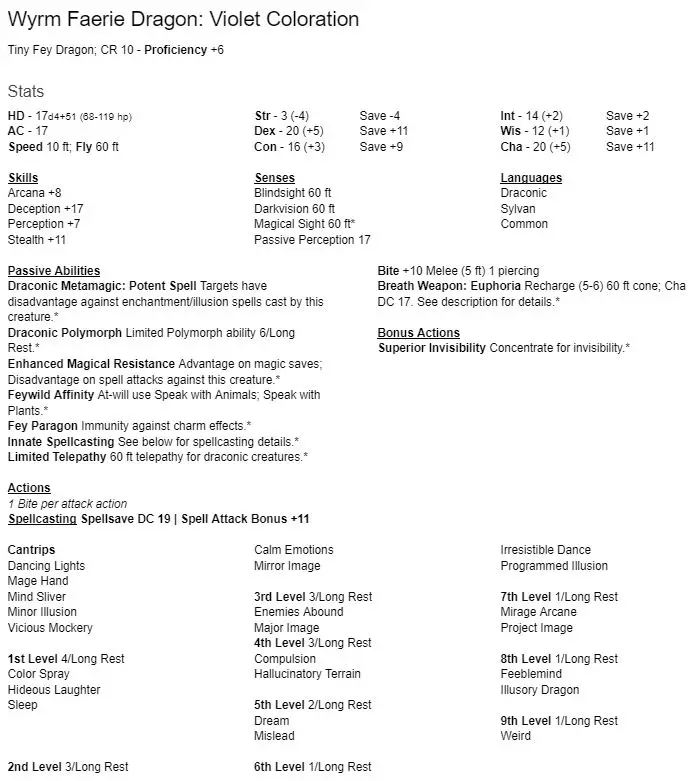
*Full description found previously in the article
The final stage in the “evolution” of this little terror, Weird never seemed so appropriate than to be placed on the spell list for the Faerie Dragon. Feeblemind works wonders as it has the ability to reset the most inconvenient investigators that are looking for a tiny little dragon prankster that can pack a punch. The only limitations are the fact that the most interesting things it can do, it can only do once, and is an either-or kind of situation. Remember that this creature is intelligent and will be able to plan ahead of whatever the party is willing to throw at it.
Encounters
Using Faerie Dragons in encounters will run very differently than your typical “roll initiative and brawl” scenario. The most important thing to remember is that the dragon doesn’t want to be in a fight. If there is one thing that you can take away from this is that fighting is always the last option for this creature, it will attempt to run away at every possible opportunity and will attempt to distract enemies to the point of using magic to force them to attack each other.
Added Minions
Adding the Feydragon as a minion works well as they are perfect to be in the support role in any given encounter. They will attempt to hide and work their magic to fool or redirect enemies to do things that are bad tactics. Dropping in a Major Image or casting Enemies Abound in a critical moment to aid a baddy is what they do best. It is also important to mention that they don’t need to do something every time it is their turn. If no one sees them, then they might be content to lay low until the perfect moment where their spellcasting support would be the greatest benefit.
With the low-end challenge ratings even for the Wyrm Dragon, this creature is readily made to be Minion support. Spicing up an encounter with even a young dragon would confuse the party and drive their paranoia. The dragon doesn’t have to be aligned with the parties’ enemy. They could be a third party trying to stir the pot.
Support / Sub-Boss
Using a Faerie Dragon Wyrm as a support element or sub-boss for a more powerful true dragon such as an Ancient Red or Gold Dragon would change the very nature of the encounter. Add in Hallucinatory Terrain or a Mirage Arcane to hide a lair or the hoard, including a library in a dragon’s lair that would contain books of local history that includes the most insignificant events of a locale. Using powerful support spells like Illusory Dragon, Weird (I know, it’s not as great as I want it to be), Feeblemind, and Irresistible Dance. This small dragon can hide in its own illusions and really mess with the party as they are trying to concentrate on dealing with a major threat. You could also add in additional lair actions and effects that compliment the Faerie Dragon, implementing illusions and enchantments that nag at the party.
The Feydragon could be a historian or jester for a larger dragon, set to entertain and catalog as needed. Since the Faerie Dragon “hoards” different things than what a true dragon cares about, this seems like a perfect combination of building a more interesting plot. I could see a plot where the party manages to bribe a Faerie Dragon to give up the secrets of a treasure hoard. Alternatively you could set up the Feydragon as a type of spymaster for a bigger badder boss, its ability to speak with animals and plants could be useful if those animals and plants can feed information into an elaborate spy network.
Solo Encounter
Solo encounter’s will be rare, the party would need to find the Faerie Dragon first. With the dragon’s penchant for knowing all the comings and goings within an area, it is likely that the creature would see the setup for a trap or attack before it materializes. They then have a couple of options, the dragon could spring the trap and counter the trap directly, or they could just avoid the trap and leave the party hanging. While I could think of quite a few situations where a creative party could lure a Faerie Dragon into a trap, I would think that the dragon knows it’s a trap and is confident that it would be able to escape should things get bad.
Setup
Faerie Dragons love pranks, one of the few ways to trick a dragon into combat would be to entice it with an epic prank. If it smells the potential for violence it will redirect the source of the violence and turn any potential trap into one of its own. Faerie Dragons don’t wish to see creatures die, but are not opposed to it if their life is in danger, and while they have the ability to deal damage directly, they prefer to have other creatures do their dirty work.
Surprise Round
The surprise round would be a great time for the dragon to set up whatever will be next; establishing an illusion, charming the party’s heavy hitter and fooling them into thinking that attacking an ally would be the best idea—doing all of this from an epic hiding spot where it could see all the action would be ideal. This is a good chance for the game master to be creative with charm and illusion magic.
Subsequent Rounds
The end goal of the Faerie Dragon is for the party to bumble around constantly trying to figure out where a threat is coming from. The more the dragon can make a fool of the party, particularly the most intelligent one, the more it will attempt to do so. It is a natural prankster and will do all of this from hiding to avoid any direct conflict. If it is spotted, and something threatens it directly the Feydragon will attempt to become invisible and flee. It will consider self-preservation more important than anything else, and a single attack (even if it misses) will be enough for it to abandon the field. As long as the dragon can keep the party stepping over each other and guessing about the source of the embarrassment, the combat will continue. It is also important to note that the death of the party is not the end goal, it only wishes to be entertained and not threatened.
Noncombat
Faerie Dragons are notorious for their pranks, but equally so, they are capable gatherers of information. They prefer to deal with others in a nonviolent manner as they are able to greatly benefit from barter over combat. The second most difficult part of dealing with a Faerie Dragon is finding it, as it will layer its lair in illusions to hide it from prying eyes and ears that would spy its treasure. By far the most difficult part of working with a Feydragon is attempting to get anything useful out of it.
The dragon makes it its business to know everything about everything. It will likely know the information that a party seeks, but you’ll have to get past the dull boring details of all the things that it knows and thinks is important to the party. If it believes that a piece of information is important to someone it will ask for a bribe, and what that bribe could be depends on the nature of the information and the age of the dragon negotiating. A younger dragon might like a bauble or a sweet treat in exchange, but an older dragon could request information of equal value that they could use in later negotiations.
The Faerie Dragon would prefer non-combat negotiations over any direct encounter, especially if it perceives a party as being much more physically powerful than it. Negotiations might take place with the use of Mislead or Project Image, revealing itself to potential enemies is a quick way to get killed and this spell would enable the dragon to participate and even potentially conclude negotiations and trade without ever stepping into a dangerous situation.
Multiple Faerie Dragons Encounter
While not typical, in some cases, Faerie Dragons will work together. Dragons that find themselves within the confines of a city may set up a small clutch of Feydragons to assist each other in their goals. It is common in these kinds of arrangements that they spend as much time pranking each other as they would anybody else in the general area. They are loath to share information with each other, and will actively try to hide knowledge from other members of the same clutch.
Arrangements where Feydragons mutually help each other usually don’t last long as they like to hoard the same things. They will eventually become jealous of each other and will attempt to drive the others away. A spectacle of Faerie Dragons fighting is not one of brute strength or powerful blows, but instead is a bewildering array of illusions expressing creativity in bizarre and fantastic displays. The winner is the one that can best impress the other and force them to move to a different locale.
If a clutch is still active when it is threatened, they will work together but separately in order to ward off an interloper. This is displayed similarly to how a head-to-head challenge would play out, but it would be directed at whatever or whoever threatens the clutch.
Setup
With multiple Feydragons occupying the same area there is the assumption that the volume of pranks and mishaps will go up as well, especially if they’re competing with each other. If they believe that violence will be a result of an encounter then they will approach with caution and have back in the form of other dragons in the clutch just in case things get out of hand. With multiple dragons the possibility for an uncontrolled brawl and confusion within the aggressor’s own party is likely as they will target the most likely candidates that would fall victim to their spells and do the most damage to the party internally.
Surprise Round
This is where things could get interesting as a game master. With many Feydragon’s setting up for their own individual brand of chaos and confusion, there is potential for a lot of pieces moving all at once. Each dragon is going to attempt to set up its own illusions, distractions, or confusion. The potential ridiculousness of the encounter has the setup to be epic. Be super creative as the StoryCrafter and remember that Faerie Dragons will actively not work together in this sense, even in the interest of a common goal, as it doesn’t just matter that the clutch is victorious (i.e., run away and escape). The dragon who has the best distraction would win points and potentially gain status within the group. Treat this as a competition between the members of the clutch rather than a collaboration.
Subsequent Rounds
This will be a continuation of the surprise round, the setup of the tricks that all the dragons have in their arsenal come into fruition. The clutch will likely give special credence to the dragon that successfully fools the party or lasts the longest against them in the fight (while still not actually engaging in combat). The party will have a difficult time ensuring that the dragons don’t immediately escape after the combat begins.
Noncombat
The potential amount of information, useful or otherwise, that a clutch of Faerie Dragons possesses could fill libraries. A clutch would be open to bartering for that information if the right assurances are made, and they aren’t put into direct danger. Finding the clutch would be much more simple than finding an individual Feydragon, as the localization of strange events or extreme drama would give away their operational area.
Coordination is not the Faerie Dragon’s strong suit and it is safe to assume that most of the information that is contained within the clutch is overlapped with multiple members of the group. Getting one dragon to give up information would be easy as they would be apt to compete with the other dragon’s to gain favor in the group. However, each dragon would have their version of events and information, skewed by their own point of view and how they acquired the information. It is also likely that they would indulge heavily if they believe it’s what you want to hear.
Non-combat negotiations are what the clutch would prefer but they would want the discussion and selling of information to be in front of the clutch in order to gain status. This would prompt live exchanges and will usually include observers from the clutch hidden in the background. They would want to keep any exchange of information to be secret and may insist that whispering and secret codes be used so they can hoard what is gained against the rest of the clutch.
Faerie Dragons Wrap Up
The Faerie Dragon is a missed opportunity for the game, it has so much potential as I’ve hopefully outlined here. It disappoints me that it is reduced to such a small section of the Monster Manual. The non-combat potential of the creature is limitless, and I wish that this kind of content would be focused on more. The Faerie Dragon can be such a cool addition to any session or campaign, the negotiation for information and possibly convincing a creature to be an ally in a support role would be a memorable moment. The limitless variation of personality and character in the Faerie Dragon could set into motion an epic chain of events in your plot. Using this creature as a foundation of lore and depth could bring so much to your table. I hope that you’ll be able to use it to its full potential and that I’ve inspired you to expand your play.
Until next time
Mike aka RPG StoryCraft

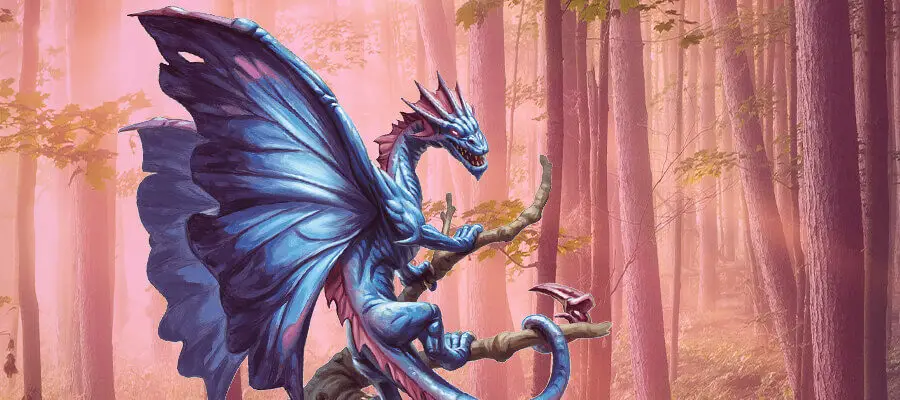


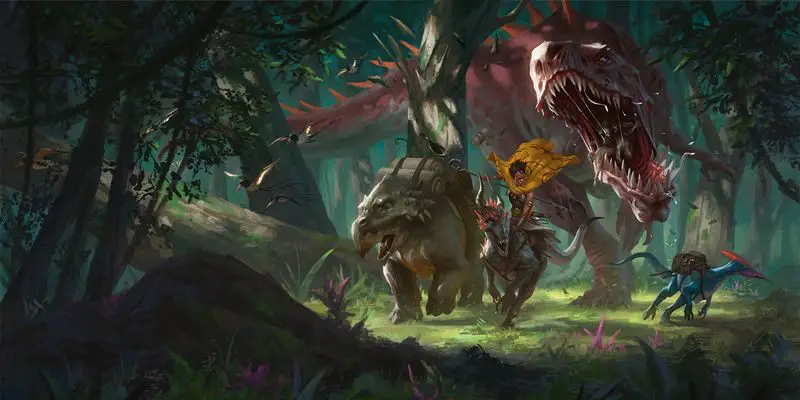
This is some great stuff!
Added to the Blog Database.